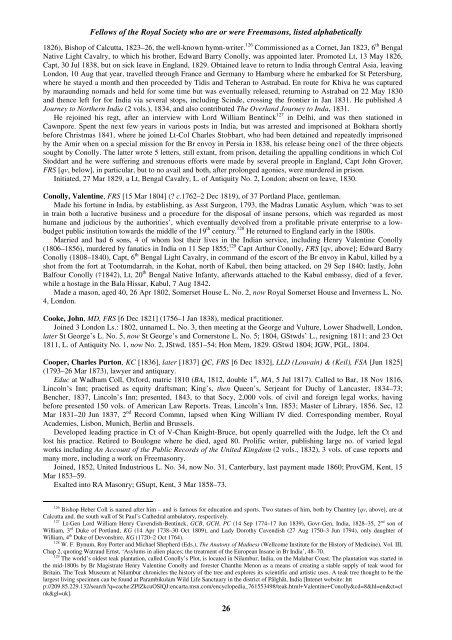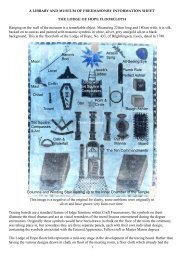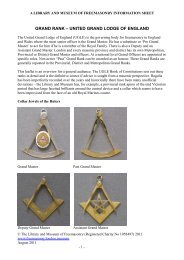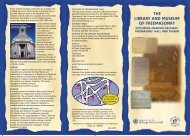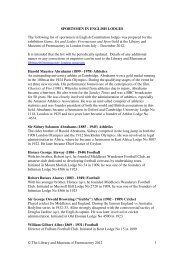FREEMASONS AND THE ROYAL SOCIETY Alphabetical List of ...
FREEMASONS AND THE ROYAL SOCIETY Alphabetical List of ...
FREEMASONS AND THE ROYAL SOCIETY Alphabetical List of ...
Create successful ePaper yourself
Turn your PDF publications into a flip-book with our unique Google optimized e-Paper software.
Fellows <strong>of</strong> the Royal Society who are or were Freemasons, listed alphabetically<br />
1826), Bishop <strong>of</strong> Calcutta, 1823–26, the well-known hymn-writer. 126 Commissioned as a Cornet, Jan 1823, 6 th Bengal<br />
Native Light Cavalry, to which his brother, Edward Barry Conolly, was appointed later. Promoted Lt, 13 May 1826,<br />
Capt, 30 Jul 1838, but on sick leave in England, 1829. Obtained leave to return to India through Central Asia, leaving<br />
London, 10 Aug that year, travelled through France and Germany to Hamburg where he embarked for St Petersburg,<br />
where he stayed a month and then proceeded by Tidis and Teheran to Astrabad. En route for Khiva he was captured<br />
by maraunding nomads and held for some time but was eventually released, returning to Astrabad on 22 May 1830<br />
and thence left for for India via several stops, including Scinde, crossing the frontier in Jan 1831. He published A<br />
Journey to Northern India (2 vols.), 1834, and also contributed The Overland Journey to Inda, 1831.<br />
He rejoined his regt, after an interview with Lord William Bentinck 127 in Delhi, and was then stationed in<br />
Cawnpore. Spent the next few years in various posts in India, but was arrested and imprisoned at Bokhara shortly<br />
before Christmas 1841, where he joined Lt-Col Charles Stobbart, who had been detained and repeatedly imprisoned<br />
by the Amir when on a special mission for the Br envoy in Persia in 1838, his release being one1 <strong>of</strong> the three objects<br />
sought by Conolly. The latter wrote 5 letters, still extant, from prison, detailing the appalling conditions in which Col<br />
Stoddart and he were suffering and strenuous efforts were made by several preople in England, Capt John Grover,<br />
FRS [qv, below], in particular, but to no avail and both, after prolonged agonies, were murdered in prison.<br />
Initiated, 27 Mar 1829, a Lt, Bengal Cavalry, L. <strong>of</strong> Antiquity No. 2, London; absent on leave, 1830.<br />
Conolly, Valentine, FRS [15 Mar 1804] (? c.1762–2 Dec 1819), <strong>of</strong> 37 Portland Place, gentleman.<br />
Made his fortune in India, by establishing, as Asst Surgeon, 1793, the Madras Lunatic Asylum, which ‘was to set<br />
in train both a lucrative business and a procedure for the disposal <strong>of</strong> insane persons, which was regarded as most<br />
humane and judicious by the authorities’, which eventually devolved from a pr<strong>of</strong>itable private enterprise to a lowbudget<br />
public institution towards the middle <strong>of</strong> the 19 th century. 128 He returned to England early in the 1800s.<br />
Married and had 6 sons, 4 <strong>of</strong> whom lost their lives in the Indian service, including Henry Valentine Conolly<br />
(1806–1856), murdered by fanatics in India on 11 Sep 1855; 129 Capt Arthur Conolly, FRS [qv, above]; Edward Barry<br />
Conolly (1808–1840), Capt, 6 th Bengal Light Cavalry, in command <strong>of</strong> the escort <strong>of</strong> the Br envoy in Kabul, killed by a<br />
shot from the fort at Tootumdarrah, in the Kohat, north <strong>of</strong> Kabul, then being attacked, on 29 Sep 1840; lastly, John<br />
Balfour Conolly (†1842), Lt, 20 th Bengal Native Infanty, afterwards attached to the Kabul embassy, died <strong>of</strong> a fever,<br />
while a hostage in the Bala Hissar, Kabul, 7 Aug 1842.<br />
Made a mason, aged 40, 26 Apr 1802, Somerset House L. No. 2, now Royal Somerset House and Inverness L. No.<br />
4, London.<br />
Cooke, John, MD, FRS [6 Dec 1821] (1756–1 Jan 1838), medical practitioner.<br />
Joined 3 London Ls.: 1802, unnamed L. No. 3, then meeting at the George and Vulture, Lower Shadwell, London,<br />
later St George’s L. No. 5, now St George’s and Cornerstone L. No. 5; 1804, GStwds’ L., resigning 1811; and 23 Oct<br />
1811, L. <strong>of</strong> Antiquity No. 1, now No. 2, JStwd, 1851–54; Hon Mem, 1829. GStwd 1804; JGW, PGL, 1804.<br />
Cooper, Charles Purton, KC [1836], later [1837] QC, FRS [6 Dec 1832], LLD (Louvain) & (Keil), FSA [Jun 1825]<br />
(1793–26 Mar 1873), lawyer and antiquary.<br />
Educ at Wadham Coll, Oxford, matric 1810 (BA, 1812, double 1 st , MA, 5 Jul 1817). Called to Bar, 18 Nov 1816,<br />
Lincoln’s Inn; practised as equity draftsman; King’s, then Queen’s, Serjeant for Duchy <strong>of</strong> Lancaster, 1834–73;<br />
Bencher, 1837, Lincoln’s Inn; presented, 1843, to that Socy, 2,000 vols. <strong>of</strong> civil and foreign legal works, having<br />
before presented 150 vols. <strong>of</strong> American Law Reports. Treas, Lincoln’s Inn, 1853; Master <strong>of</strong> Library, 1856. Sec, 12<br />
Mar 1831–20 Jun 1837, 2 nd Record Commn, lapsed when King William IV died. Corresponding member, Royal<br />
Academies, Lisbon, Munich, Berlin and Brussels.<br />
Developed leading practice in Ct <strong>of</strong> V-Chan Knight-Bruce, but openly quarrelled with the Judge, left the Ct and<br />
lost his practice. Retired to Boulogne where he died, aged 80. Prolific writer, publishing large no. <strong>of</strong> varied legal<br />
works including An Account <strong>of</strong> the Public Records <strong>of</strong> the United Kingdom (2 vols., 1832), 3 vols. <strong>of</strong> case reports and<br />
many more, including a work on Freemasonry.<br />
Joined, 1852, United Industrious L. No. 34, now No. 31, Canterbury, last payment made 1860; ProvGM, Kent, 15<br />
Mar 1853–59.<br />
Exalted into RA Masonry; GSupt, Kent, 3 Mar 1858–73.<br />
126 Bishop Heber Coll is named after him – and is famous for education and sports. Two statues <strong>of</strong> him, both by Chantrey [qv, above], are at<br />
Calcutta and. the south wall <strong>of</strong> St Paul’s Cathedral ambulatory, respectively.<br />
127 Lt-Gen Lord William Henry Cavendish-Bentinck, GCB, GCH, PC (14 Sep 1774–17 Jun 1839), Govr-Gen, India, 1828–35, 2 nd son <strong>of</strong><br />
William, 3 rd Duke <strong>of</strong> Portland, KG (14 Apr 1738–30 Oct 1809), and Lady Dorothy Cavendish (27 Aug 1750–3 Jun 1794), only daughter <strong>of</strong><br />
William, 4 th Duke <strong>of</strong> Devonshire, KG (1720–2 Oct 1764).<br />
128 W. F. Bynum, Roy Porter and Michael Shepherd (Eds.), The Anatony <strong>of</strong> Madness (Wellcome Institute for the History <strong>of</strong> Medicine), Vol. III,<br />
Chap 2, quoting Watraud Ernst, ‘Asylums in alien places; the treatment <strong>of</strong> the European Insane in Br India’, 48–70.<br />
129 The world’s oldest teak plantation, called Conolly’s Plot, is located in Nilambur, India, on the Malabar Coast. The plantation was started in<br />
the mid-1800s by Br Magistrate Henry Valentine Conolly and forester Chanthu Menon as a means <strong>of</strong> creating a stable supply <strong>of</strong> teak wood for<br />
Britain. The Teak Museum at Nilambur chronicles the history <strong>of</strong> the tree and explores its scientific and artistic uses. A teak tree thought to be the<br />
largest living specimen can be found at Parambikulam Wild Life Sanctuary in the district <strong>of</strong> Pālghāt, India [Intenet website: htt<br />
p://209.85.229.132/search?q=cache:ZPlZkcuOSlQJ:encarta.msn.com/encyclopedia_761553498/teak.html+Valentine+Conolly&cd=8&hl=en&ct=cl<br />
nk&gl=uk].<br />
26


